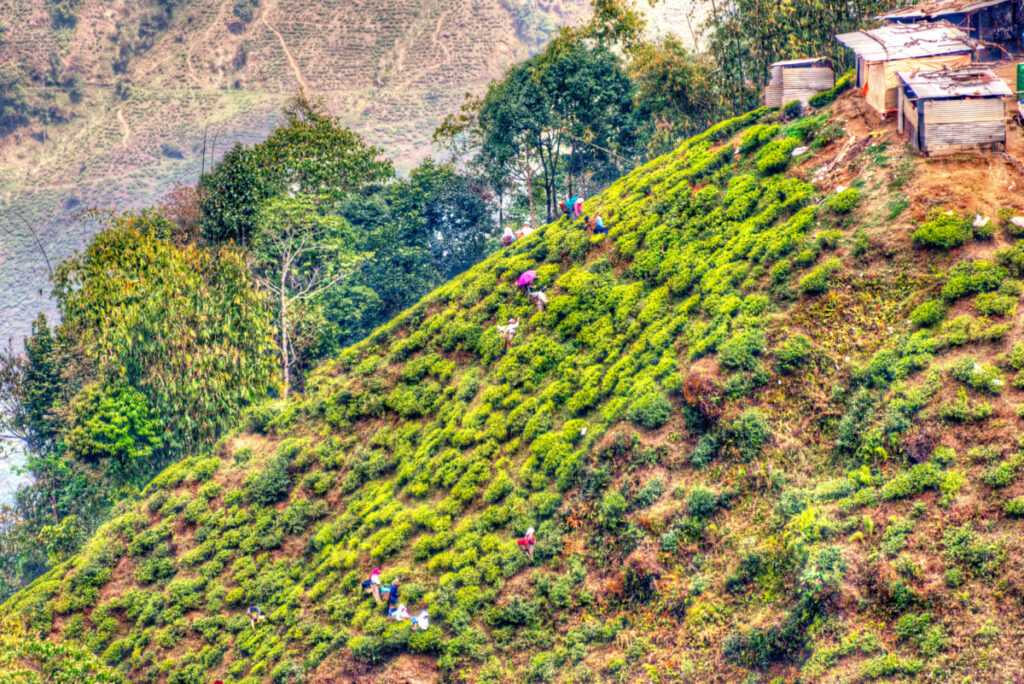Imagine, if you will, an envelope that floated into my world like a clandestine secret carried by the wind. It was no ordinary invitation, not ink and parchment, but a promise painted with the colors of Darjeeling’s undulating hills and the fragrant whispers of tea leaves. This letter was more than just an invitation; it was a soulful murmur from the heart of a dear friend, summoning me to the mystical realm of the Teesta Tea and Tourism Festival in the Darjeeling District of West Bengal, India.
It all began with that singular envelope—its edges gently crinkled, as if to keep the secret it held even more secure. I carefully unsealed it, unveiling the call to adventure. It was an invitation to explore the world of Teesta Tea and Tourism, an experience that beckoned with the promise of uncharted landscapes, the aroma of freshly plucked tea leaves, and the warm embrace of local culture.
Darjeeling’s Enchanting Overture
As I arrived in the land of Darjeeling, a symphony of natural beauty greeted me. The air was cool and crisp, and the town was nestled amidst the majestic Himalayas. Its meandering, winding streets whispered tales of the vibrant blend of Indian, Tibetan, and British influences that painted the canvas of this enchanting region.
Darjeeling was my gateway to the experience that awaited me, a place where the lines between cultures blurred and merged seamlessly, creating a tapestry of diversity.
My base for this journey was a tea estate known as “Glenview,” perched at an altitude that offered breathtaking panoramic views of the hills. Glenview was celebrated not only for its tea production but also for the warm hospitality that awaited travelers like me. As I checked into the estate’s guesthouse, a warm cup of tea was handed to me, and I felt the first stirrings of anticipation for the days ahead.
Staying in a Darjeeling tea estate offers a unique and enchanting escape. Nestled amidst the rolling hills, these estates open their doors to travelers seeking a tranquil retreat. You become part of the tea-making process, from witnessing the plucking of tea leaves to guided tours of the tea factory. The highlight is the tea-tasting sessions, where you savor the distinct flushes of Darjeeling tea. Beyond tea, immerse yourself in the serene Himalayan ambiance, explore local culture, and indulge in adventure activities like white-water rafting. These stays aren’t just accommodations; they are invitations to a world where tea, nature, and culture blend harmoniously.
The Art of Crafting Tea
The heart of my Teesta Tea and Tourism adventure lay in the tea gardens themselves. These gardens, like rolling canvases, unfolded a visual delight that stretched as far as the eye could see. Meticulously maintained rows of tea bushes swayed gently in the sunlight, their leaves creating intricate patterns of light and shadow.
My journey into the art of tea cultivation began with a guided tour of Glenview’s tea factory. Here, I was introduced to the intricate process of tea production. The guide spoke in hushed tones as he unraveled the secrets of tea making. From the plucking of the leaves to the withering, rolling, oxidation, and drying—each step was an essential stroke in the masterpiece of tea craftsmanship.
The scent of tea leaves being processed filled the air, a captivating fragrance that would linger in my memory long after my departure.
Sipping the Symphony
Tea was not just a beverage; it was a symphony of flavors, a poetry of the senses. It was time for my inaugural tea-tasting session. I was led to a room with large windows that framed the picturesque landscape outside. On a wooden table lay an array of tea cups, each holding different flushes of Teesta Tea.
Darjeeling tea, often hailed as the ‘champagne of teas,’ is a black tea made from Camellia sinensis, grown and processed in the Darjeeling District of West Bengal. Since 2004, this description has been further refined to be a registered geographical indication. To be labeled as Darjeeling tea, the tea leaves must be produced on specific estates within the Darjeeling and Kalimpong area.
The first sip was a revelation. The first flush, often called the “Spring Flush,” boasted a delicate, floral note. Its light color and briskness made it perfect for a sunny afternoon. The second flush, known as the “Summer Flush,” was bold and robust, with a distinct muscatel flavor that left a sweet aftertaste. Darjeeling tea, known for its sweet taste and floral aroma, has a light color, thin texture, and musky notes. It sometimes carries fruity and citrus flavors, and has even been likened to muscat wine.
The tea expert, more a tea poet than an instructor, explained that the unique flavor profiles of Darjeeling tea were influenced by factors such as elevation, soil quality, and the precise timing of leaf plucking. As I sipped and savored the teas, I couldn’t help but marvel at the rich tapestry of flavors that this humble leaf could yield.
Darjeeling Toy Train Ride and Tea Tourism
My adventure in Darjeeling reached new heights when I combined the iconic Darjeeling Himalayan Railway, affectionately known as the “Toy Train,” with the region’s renowned tea tourism. This unique journey promised not just a ride on a UNESCO World Heritage narrow-gauge railway but also a deeper immersion into the heart of Darjeeling’s tea culture.
The Toy Train, a charming vintage railway, chugs through the picturesque landscapes of Darjeeling. As I boarded the train, the distinct whistles and the rhythmic clickety-clack of the tracks set the stage for a nostalgic journey. The train’s small, colorful coaches, reminiscent of a bygone era, provided a window to the world outside.
As the Toy Train made its way through the rolling hills and forests, I was treated to breathtaking views of the town, the Himalayan peaks, and the lush tea gardens that carpeted the landscape. The slow pace of the journey allowed me to savor every moment and capture the essence of Darjeeling’s natural beauty.
Strolling Through Paradise
The tea gardens weren’t just workplaces; they were portals to paradise. I embarked on leisurely walks through the tea bushes, guided by the soft caress of the Himalayan breeze. The backdrop of distant Himalayan peaks added an otherworldly dimension to the scenery.
As I strolled, I observed the tea pluckers, their baskets gracefully slung over their shoulders. They moved with an almost poetic rhythm, plucking the tender leaves with a precision that came from generations of expertise. It was a living tradition, an art form passed down through time.
A Culinary and Cultural Extravaganza
My exploration of Darjeeling was incomplete without delving into the local culture and cuisine. The town’s streets were adorned with charming tea shops, where one could savor a steaming cup of Teesta Tea while soaking in the ebb and flow of life outside. These tea shops were not just places to enjoy a beverage; they were gathering spots where conversations flowed like the tea itself.
I also had the opportunity to savor local dishes, each a delightful blend of Indian, Tibetan, and British influences. Momos, those Tibetan dumplings, were an instant favorite, and a bowl of Thukpa, a Tibetan noodle soup, warmed my heart and soul. The desserts, infused with the essence of tea, were an unexpected delight.
The Festival of Colors and Culture
One of the highlights of my tea tourism adventure was the Teesta Tea and Tourism Festival. The town of Darjeeling erupted with vibrant colors and resonated with music, dance, and the fragrant notes of freshly brewed tea. This festival celebrated the rich tea heritage of the region, offering traditional performances and cultural showcases.
I had the privilege of interacting with tea experts and artisans, each an eloquent storyteller in their own right. The festival featured numerous tea stalls, each offering a different facet of Teesta Tea. It was a celebration of the beverage that had drawn me to this enchanting land, a tribute to the art of tea.
Darjeeling Ropeway and Tea Tourism: My Enriching Experience
Combining the Darjeeling Ropeway with a deep dive into tea tourism was a decision that enriched my journey through this enchanting region. The Darjeeling Ropeway, also known as the “Rangeet Valley Passenger Cable Car,” offered a breathtaking aerial perspective of the town and its surrounding tea gardens. As the cable car gracefully ascended, I found myself suspended in the sky, enveloped by misty mountains and lush tea plantations below. It was a serene moment, to say the least.
Reaching the Singmari station, I entered the realm of Darjeeling’s tea culture. The guided tours of Happy Valley Tea Estate and Tenzing Rock Tea Estate unveiled the intricate process behind every cup of Darjeeling tea. From leaf plucking to sorting and processing, I marveled at the craftsmanship involved. The tea-tasting sessions, featuring a diverse range of Darjeeling tea flushes, painted a symphony of flavors on my palate. My interaction with tea pluckers, the unsung heroes of the tea industry, added depth to my understanding. This adventure wasn’t just about panoramic views; it was a gateway to the heart of Darjeeling’s culture, tradition, and tea-scented landscapes. It left me with a profound appreciation for the “champagne of teas” and a longing to return to this Himalayan gem.
White River Rafting in Melli, Darjeeling
As I reluctantly bid farewell to Glenview and the mesmerizing hills of Teesta, a new adventure beckoned. It was time for an exhilarating experience that would add a thrilling crescendo to my journey—an expedition into the wild waters of the Teesta River.
Melli, a charming hamlet in Darjeeling, is renowned for its white-water rafting experiences. The Teesta River, with its turbulent rapids and breathtaking landscapes, is a paradise for adventure seekers. Equipped with a sturdy raft, a helmet, and a life jacket, I embarked on this adrenaline-pumping adventure.
The river’s rapids tested our mettle, each rapid bringing a rush of excitement and a splash of cold, refreshing water. As I navigated the twists and turns of the Teesta, I couldn’t help but marvel at the contrast between the tranquility of the tea gardens and the exhilaration of the river.
A Keepsake of Teesta Tea
Before bidding farewell, I couldn’t resist the urge to carry a piece of Teesta with me. I ventured into a local market, where I purchased freshly packed Teesta Tea. These carefully packaged boxes held not just tea leaves but the essence of my journey—a memento that would allow me to savor the memories long after my return home.
As I reluctantly bid farewell to Glenview and the mesmerizing hills of Teesta, I made a solemn promise to myself. My adventure in tea tourism was more than a mere visit; it was an immersion into a world where the love for tea intertwined seamlessly with the beauty of nature and the warmth of local culture.
Teesta had etched itself into my heart, and I knew that one day, in the not-so-distant future, I would return to these enchanted hills. For in Teesta, I had discovered more than just a destination; I had unearthed a symphony in a cup. It was a place where time seemed to linger, where every sip was a verse, and where every experience was etched in the very soul of the Himalayas.


1 thought on “Tea Tourism in Darjeeling: Symphony of the “Champagne of Teas”, Mountains and Culture”
Comments are closed.